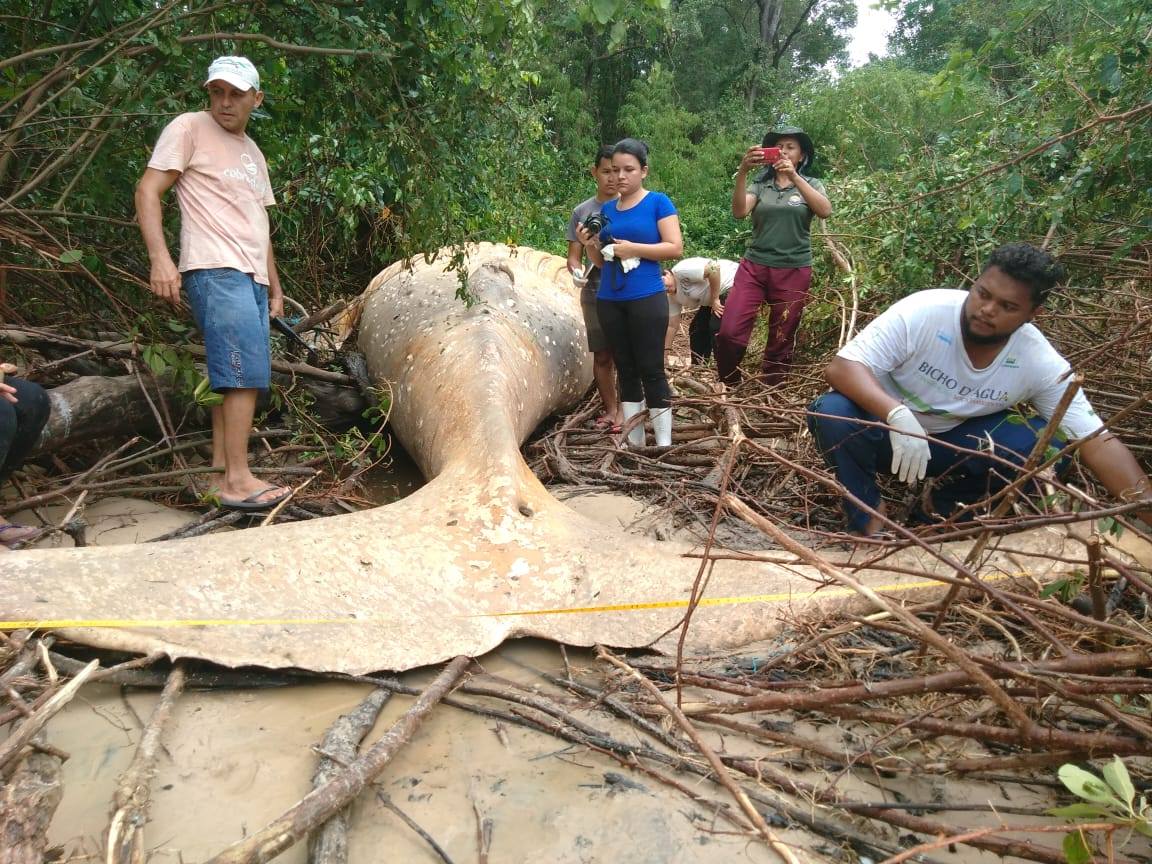2019, February 25: An Amazon Humpback
On February 23, 2019, a Brazilian conservation group named Bicho D'água announced the discovery of a humpback whale carcass in the Amazon Jungle, and released the following pictures (among others) of the body in their Facebook page.


The first photos released. [Larger versions and additional photos here]
The same Facebook post explained that the whale was actually a young animal, likely only about a year old, and that it was 8 meters long (a little over 26 feet). The carcass was on a small island called Marajó in the mouth of the Amazon River, about 15 meters (49 feet) from Araruna Beach. They guessed that it had been washed ashore during a "macro tide," which is when the level of the water rises 4 meters (13 feet!) or more above it's normal level... which would explain why it landed so far from the beach.
On the same day an article on the matter appeared in the O Tempo Brasil website, with additional pictures, and a very different assessment of the situation. First off, their pictures -- of which I show the first below -- was picked up by international websites and news services, and became the first thing seen by most people:


Pictures from O Tempo Brasil. [Larger versions here]
According to O Tempo Brasil, the whale was actually 11 metres (36 feet) long by 6 metres (19 feet) wide, and "possibly an adult of the species," which are details the website attributed to the Secretaria Municipal de Saúde, Saneamento e Meio Ambiente [Municipal Health, Sanitation and Environment Secretariat] in Semma. Please note that the two photos published by O Tempo Brasil do not give a good sense of the animal's actual size, but the pictures published by Bicho D'água clearly show the whale was not 19 feet wide, even if you included the flippers to boost its size.
O Tempo Brasil also stated that no one could explain how the animal had come to be where it was found. Yet the Bicho D'água's group had a reasonable idea for how the whale could have landed there.
These discrepancies don't appear to be purposeful. The O Tempo Brasil article was posted at 6:14PM, and the Bicho D'água Facebook post was published at 6:25PM... so it's likely O Tempo Brasil was simply publishing some of the initial guesses about the matter and didn't have the Bicho D'água group's observations available, leading to the differences between the two.
O Tempo Brasil pointed out that the during this time of year the waters from the Amazon are pushing fresher water out, which discourages whales from swimming in the mouth of the river; during the summer, more salty water invades the mouth, and whales are not an unusual visitor. Which means it's very unusual for a whale to be anywhere close to Marajó Island at this time of year to start with.
Bicho D'água postulated that the young whale had become separated from its family group and died at sea, and the macro tides had floated the body in and dropped it off... so the saltiness of the water wouldn't have mattered. The group took samples from the carcass to help determine the cause of death, and planned to bury the rest.
Anomalies -- the Strange & Unexplained, as well as my other website -- Monsters Here & There -- are supported by patrons, people like you! All new Anomalies articles are now posted for my patrons only, along with exclusive content made just for them. You can become a patron for just $1 a month!
|








